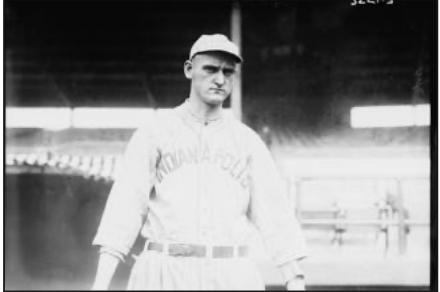July 19, 1914: Hoosiers’ George Kaiserling muzzles Terriers
The St. Louis faithful filed into Handlan’s Park hoping their Terriers would avoid a four-game sweep by the second-place Indianapolis Hoosiers, who were fighting to reduce the two-game deficit between themselves and Joe Tinker’s league-leading Chi-Feds of Chicago. The home team was buried in seventh place, 13 games off the pace.
On the hill for the Terriers was Bob Groom, who was 8-10. His first five major-league years were with the Washington Senators, where he was overshadowed by Walter Johnson. Groom had a good fastball and a wicked curve. He was a tough, underrated right-hander. His batterymate was Harry Chapman, who was pretty much an unknown entity. Although he had spent parts of the previous two seasons with the Chicago Cubs (1912) and the Cincinnati Reds (1913), Chapman had played in only three games with six plate appearances for the two teams.
The starting hurler for the Hoosiers was right-hander George Kaiserling, a Buckeye1 who was doing yeoman service for his team. At 21 he was the youngest of a four-man starting rotation; his three starter mates averaged 31 years old.2 He was coming to the mound with an 8-2 record. Behind the plate was a diehard Hoosier from Bedford, Indiana, Bill Rariden, a veteran of five years with the Boston Braves. He was accustomed to corralling the spitters and knucklers Kaiserling often threw.
Play-by-play data is not available for this game and one needs to rely on newspaper accounts. The game’s only runs were scored in the top of the fourth by the Hoosiers. We do have the play-by-play for that half-inning.
Third baseman Bill McKechnie3 of the Hoosiers led off and made the first out in an unknown way. Benny Kauff, often described as the “Ty Cobb of the Federal League,”4 hit a solid liner to right field to take first base. Frank LaPorte, a reclamation project from the American League, hit a hot grounder to shortstop Al Bridwell, who started a projected double play with a throw to second baseman John Misse. Misse arrived on the bag at the same time as the swift Kauff, who was called safe. Whether a relay was made to first we do not know, but we do know LaPorte was safe there. Kauff and LaPorte “promptly staged a double steal,” reported the Indianapolis Star, which added, “The Hoosiers have stolen everything but the Terriers bats on their present trip.”5
Groom was in the process of intentionally walking Charlie Carr when he inadvertently released an errant floater into the strike zone. Carr took advantage of the situation and hit a single between first and second, driving in Kauff. Laporte scampered to third. Then Carr stole second. Jimmy Esmond hit the ball to Bridwell, who fumbled it, then threw wildly to Chapman at the plate, where LaPorte slid in safely while Carr took third. Kaiserling helped his own cause with a sacrifice fly that scored Carr. Rariden popped out to his opposing catcher, ending the inning and the scoring for the day.
The final score: Hoosiers 3, Terriers 0.
With so little scoring and few runners, the time of the game was only 1:23.
The shutout was Kaiserling’s only one of the season. He gave up just one hit, a single by Fred Kommers, the Terriers center fielder. He walked three. Groom also pitched a good game. He gave up two earned runs, five hits, and walked one batsman. Both Groom and Kaiserling struck out three opponents.6
The game was the only one-hitter Kaiserling pitched in his brief major-league career. He ended the season with a 17-10 record, his personal high in wins and winning percentage. He also attained personal bests in games started (33), complete games (20), and innings pitched (275⅓). He led the league in hit batsmen with 17.
In spite of the win, the Hoosiers remained two games behind the Chi-Feds for the time being.
At season’s end, Indianapolis won the Federal League pennant, finishing 1½ games ahead of the Chi-Feds. The Terriers finished in last place, 25 games behind the Hoosiers.
Sources
In addition to the sources cited in the Notes, the author consulted Baseball-Reference.com, Retrosheet.org, SABR.org, and Baseball-almanac.com.
Notes
1 Kaiserling was born, raised, and died in Steubenville, Ohio.
2 The three starters and their ages were Cy Falkenberg, 34; Earl Moseley; 26; and George Mullen, 33.
3 Bill McKechnie was the only player in either lineup who would be inducted into the National Baseball Hall of Fame.
4 Kauff was the best and flashiest player in the league. He quickly became the focus of the press, which endowed him with the “Ty Cobb” sobriquet.
5 “Kaislerling Blanks St. Louis Feds with One Hit,” Indianapolis Star, July 20, 1914.
6 The box scores on the Baseball-Reference.com and Retrosheet.org websites show no entries in the strikeout column of the batting summaries. (The columns are blank, with no zeros.) But their pitching summaries show three strikeouts for each pitcher. A good possibility is that whoever compiled the original box score learned that each pitcher struck out three, but didn’t know who the strikeout victims were.
Additional Stats
Indianapolis Hoosiers 3
St. Louis Terriers 0
Handlan’s Park
St. Louis, MO
Box Score + PBP:
Corrections? Additions?
If you can help us improve this game story, contact us.


